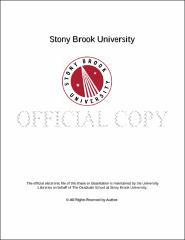| dc.identifier.uri | http://hdl.handle.net/11401/76941 | |
| dc.description.sponsorship | This work is sponsored by the Stony Brook University Graduate School in compliance with the requirements for completion of degree. | en_US |
| dc.format | Monograph | |
| dc.format.medium | Electronic Resource | en_US |
| dc.language.iso | en_US | |
| dc.publisher | The Graduate School, Stony Brook University: Stony Brook, NY. | |
| dc.type | Dissertation | |
| dcterms.abstract | The Drosophila runt gene is the founding member of the RUNX transcription factor family, a group of conserved genes that have vital roles in multiple developmental pathways throughout the animal kingdom. Runt plays important roles in segmentation, as well as in neurogenesis and sex determination in the Drosophila embryo. As a transcription factor, Runt is both an activator and a repressor of its target genes depending on the context. Sloppy-paired (slp1) is a target of runt’s activity as a pair-rule transcription factor in the segmentation pathway that is both activated and repressed by Runt. Two cis-regulatory enhancers of slp1, a Distal Early Stripe Element (DESE) and a Proximal Early Stripe Element (PESE), that mediate regulation by Runt and other pair-rule transcription factors have been characterized. The transcription factor, encoded by the odd-paired (Opa) gene, Opa is an important activator for both DESE and PESE. This thesis describes progress towards identifying Opa binding sites in these enhancers. The PESE enhancer is repressed in cells that co-express Runt and the transcription factor encoded by the fushi-tarazu (Ftz) gene. This thesis investigates the roles of Ftz and the Runt binding sites in PESE in this repression. Prior work on the regulation of the DESE and PESE enhancers revealed a non-additive interaction that could be explained if repression that involves preventing release of promoter-proximal paused RNA Polymerase II dominantly interferes with the ability of other enhancers to drive expression from this same promoter. This proposal is investigated by examining the effects of the slp1 enhancers on expression driven by a heterologous enhancer from the short-gastrulation (sog) gene. The results of these experiments and their implications on our understanding of transcription regulation during animal development are discussed. | |
| dcterms.abstract | The Drosophila runt gene is the founding member of the RUNX transcription factor family, a group of conserved genes that have vital roles in multiple developmental pathways throughout the animal kingdom. Runt plays important roles in segmentation, as well as in neurogenesis and sex determination in the Drosophila embryo. As a transcription factor, Runt is both an activator and a repressor of its target genes depending on the context. Sloppy-paired (slp1) is a target of runt’s activity as a pair-rule transcription factor in the segmentation pathway that is both activated and repressed by Runt. Two cis-regulatory enhancers of slp1, a Distal Early Stripe Element (DESE) and a Proximal Early Stripe Element (PESE), that mediate regulation by Runt and other pair-rule transcription factors have been characterized. The transcription factor, encoded by the odd-paired (Opa) gene, Opa is an important activator for both DESE and PESE. This thesis describes progress towards identifying Opa binding sites in these enhancers. The PESE enhancer is repressed in cells that co-express Runt and the transcription factor encoded by the fushi-tarazu (Ftz) gene. This thesis investigates the roles of Ftz and the Runt binding sites in PESE in this repression. Prior work on the regulation of the DESE and PESE enhancers revealed a non-additive interaction that could be explained if repression that involves preventing release of promoter-proximal paused RNA Polymerase II dominantly interferes with the ability of other enhancers to drive expression from this same promoter. This proposal is investigated by examining the effects of the slp1 enhancers on expression driven by a heterologous enhancer from the short-gastrulation (sog) gene. The results of these experiments and their implications on our understanding of transcription regulation during animal development are discussed. | |
| dcterms.available | 2017-09-20T16:51:29Z | |
| dcterms.contributor | Gergen, John P | en_US |
| dcterms.contributor | Hollingsworth, Nancy M | en_US |
| dcterms.contributor | Martin, Benjamin L | en_US |
| dcterms.contributor | Luk, Ed | en_US |
| dcterms.contributor | Small, Stephen J. | en_US |
| dcterms.creator | Higgins, Michael Luis | |
| dcterms.dateAccepted | 2017-09-20T16:51:29Z | |
| dcterms.dateSubmitted | 2017-09-20T16:51:29Z | |
| dcterms.description | Department of Biochemistry and Structural Biology | en_US |
| dcterms.extent | 106 pg. | en_US |
| dcterms.format | Monograph | |
| dcterms.format | Application/PDF | en_US |
| dcterms.identifier | http://hdl.handle.net/11401/76941 | |
| dcterms.issued | 2016-12-01 | |
| dcterms.language | en_US | |
| dcterms.provenance | Made available in DSpace on 2017-09-20T16:51:29Z (GMT). No. of bitstreams: 1
Higgins_grad.sunysb_0771E_13183.pdf: 5568002 bytes, checksum: 44e29f8b3ce69d826fff84ba185603ac (MD5)
Previous issue date: 1 | en |
| dcterms.publisher | The Graduate School, Stony Brook University: Stony Brook, NY. | |
| dcterms.subject | Developmental biology -- Genetics -- Biochemistry | |
| dcterms.subject | enhancers, even-skipped, oddpaired, runt | |
| dcterms.title | Role of Runt, Even-skipped, and Odd-paired in Regulating Enhancer activity in the Drosophila embryo | |
| dcterms.type | Dissertation | |

